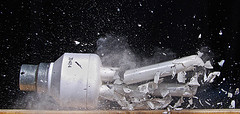- 1 read

October is Energy Awareness Month and for the past several years companies have given away sample CFL bulbs as a way to jump start Americans into thinking about energy efficiency.
Are there any light bulbs that should reasonably be replaced by CFLs or LEDs? How many bulbs are CFLs? How many potential other bulbs could be replaced? (Do not count table or floor lamps or closets for CFLs, because the risk of damage and mercury release and the infrequent use is more expensive than it is worth.)
Incandescent
Traditional bulbs use over 80% of their power to generate heat instead of light. So, they are the ultimate “clunkers.” Given that the technology is over a hundred years old, it is no surprise that the European Union has recently banned the import of incandescent bulbs due to the inefficiency relative to other choices. The light bulb profoundly changed human existence by illuminating the night and making it hospitable to a wide range of human activity. The electric light, one of the everyday conveniences that most affects our lives, was invented in 1879 by Thomas Alva Edison. He put together what he knew about electricity with what he knew about gas lights and invented a whole electrical system.
Compact Fluorescent Lighting (CFL)
Why pay for conventional incandescent lighting that uses more power to create heat than light? Many green guides and even public service TV commercials recommend using CFLs, because they use 66% less energy and last 10 times longer than incandescent bulbs. However, they have recently reached “Clunker” status relative to LED bulbs for several reasons. CFLs have mercury, which means that they need to be recycled under controlled situations. They also take longer to “warm” up than traditional bulbs and rarely have dimming capacity. The now familiar “curly cue” or “cork screw” bulbs are also deemed less attractive by many homeowners.
Light Emitting Diode (LED)
LEDs are the clear winner over the incandescent and the CFL “Clunkers.” LEDs are much less toxic than CFLs because they do not contain mercury and they light up quickly without the “warm up” time for CFLs. The new generation LEDs are also dimmable. Plus, they are easy to install in existing sockets. The operating life is 30,000 to 100,000+ hrs (10+ years), with solid-state, fast turn on, and no power surge. They are high shock/vibration resistant, and provide the major power savings. Voltages available include 12V DC, 24V DC, 110-130V AC, 220-240V AC. They also provide major reduction in heat generation and a choice of 5 colors.
One LED light bulb can easily outlast 30 incandescent bulbs, or 6 CFLs, so the savings also comes in the reduced replacement labor for commercial applications! LED bulbs cost less than the bulbs they replace. Operating 12 hours per day, LED light bulbs can last 7 years or more!
Homeowners can help bring the price down by buying more bulbs to increase the demand and mass production. Particularly because mercury is present in fluorescent lighting, LEDs are the obvious choice. A 25 Watt CFL is equal to a 100 Watt incandescent while a 16 Watt LED will have the same light output as a 100 Watt incandescent. A CFL will last 10 times as long as an incandescent, but an LED will last 100 times as long.
Cash for Clunkers – Light Bulbs
Given the incredible response to the “Cash for Clunkers Cars” program and then the “Cash for Clunkers Appliances Program,” it is only natural that there is now a Cash for Clunkers Light Bulbs” program. The offering includes buy backs for both incandescent and CFLs as well as the typical four-foot fluorescent tubes found in most commercial offices, schools, hospitals, and buildings across the country.

